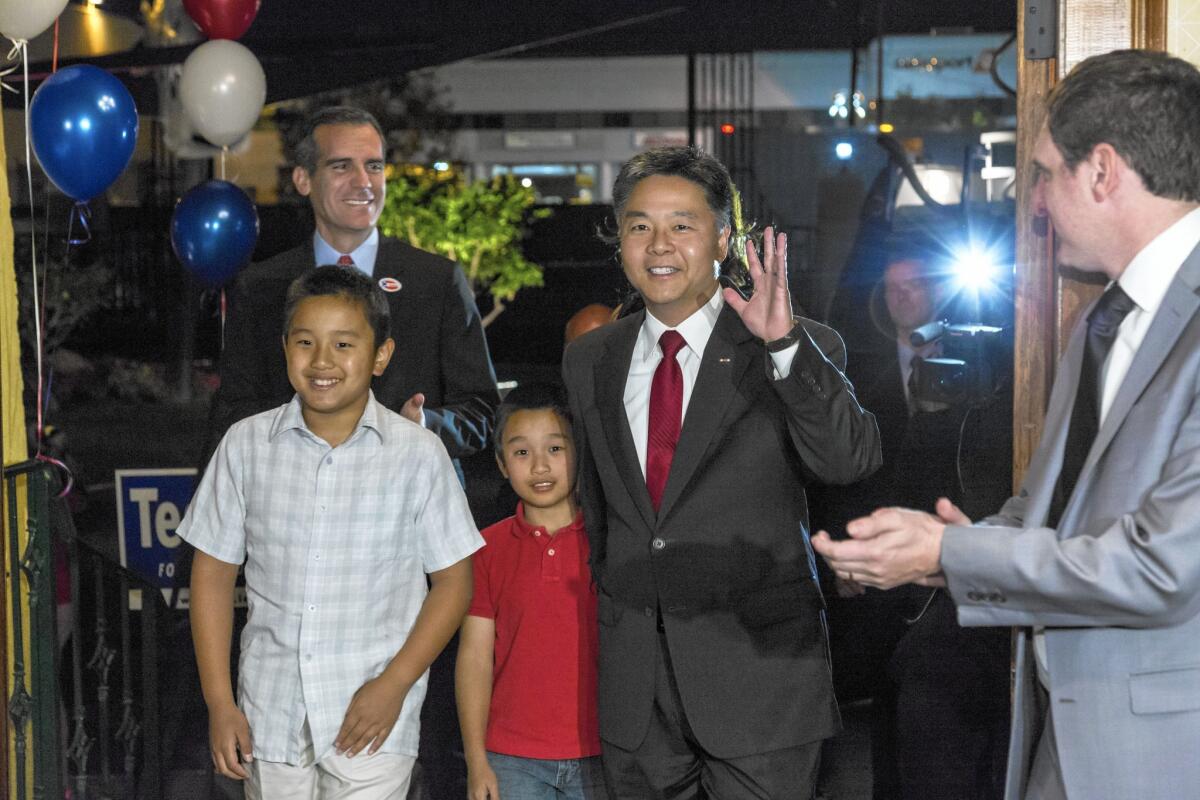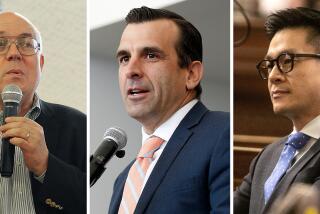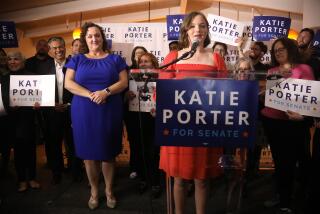Congressional races in California remain tight in late-night returns

Buffeted by lackluster turnout and President Obama’s sagging ratings, three of California’s first-term Democrats were locked in congressional contests too close to call Tuesday night. But a fourth Democratic freshman, Rep. Raul Ruiz of Palm Desert, appeared to be beating back a challenge from Republican Assemblyman Brian Nestande, according to incomplete election night returns.
Rep. Scott Peters of San Diego was in a tight race with Republican businessman Carl DeMaio, and Rep. Julia Brownley of Westlake Village was in a close contest with Republican Assemblyman Jeff Gorell of Camarillo. In Northern California, Rep. Ami Bera of Elk Grove was narrowly trailing former GOP congressman Doug Ose of Sacramento.
Elsewhere, freshman Rep. David Valadao (R-Hanford) held off a challenge by former Democratic congressional aide Amanda Renteria, who grew up in the Central Valley.
In battles for seats being left open by upcoming retirements, state Sen. Ted Lieu (D-Torrance) was well ahead of gang prosecutor Elan Carr, a Republican, in the race to succeed Rep. Henry A. Waxman (D-Beverly Hills), who is stepping down after 40 years. In the Inland Empire, Democratic Redlands Mayor Pete Aguilar was leading military veteran and businessman Paul Chabot, a Republican, for the seat being vacated by Rep. Gary G. Miller (R-Rancho Cucamonga).
In the northern reaches of L.A. County, where two Republicans competed to succeed Rep. Howard P. “Buck” McKeon (R-Santa Clarita), state Sen. Stephen Knight of Palmdale had a comfortable lead over former state legislator Tony Strickland of Camarillo.
In the state’s two other same-party congressional races, Rep. Michael M. Honda (D-San Jose) was ahead of former Obama Commerce Department official Ro Khanna of Fremont, while Rep. Tom McClintock (R-Elk Grove) beat back a challenge from an Art Moore, an Army National Guard officer and businessman.
The same-party races were made possible by California’s “top two” election system, in which first-and second-place primary finishers, regardless of party, advance to the fall.
Candidates and strategists in same-party races are still trying to figure out how to appeal to a wider pool of voters without alienating members of their own party. In the race to succeed McKeon, Strickland courted Democrats by touting endorsements from elected officials and emphasizing his support for abortion rights.
Knight emphasized his antiabortion stance and endorsements from conservative Republicans. But he drew criticism with his vote against a measure banning sales of items depicting the Confederate flag at state-owned sites and with his support from controversial Assemblyman Tim Donnelly (R-Twin Peaks).
McKeon’s district, formerly a GOP stronghold, has grown more ethnically diverse, and registration is nearly evenly divided between the two major parties.
The 17-month fight between Democrats Honda and Khanna was especially bitter and costly.
Khanna repeatedly attacked Honda as out of touch and too old-fashioned to represent the high-tech district. Honda tried to paint Khanna as a political opportunist. With total spending approaching $7million, the race was among the costliest congressional contests in the state this year.
But the handful of battles between the two major parties drew the most attention. A top goal for Republicans was to wrest control of the U.S. Senate from Democrats and to strengthen their House majority.
Democrats sought to minimize losses in a year without a presidential election to draw their base to the polls. In California, that meant trying to protect their four first-term incumbents, all of whom had won GOP-held seats in 2012, boosted by President Obama’s reelection.
With Democrats expected to win most, if not all, statewide posts, party leaders worried that many of their voters would see no need to cast ballots.
They tried to boost turnout with early, aggressive registration and get-out-the-vote efforts including a campaign to reach unmarried women, a growing segment of voters who tend to favor Democrats.
Former President Clinton and Vice President Joe Biden campaigned in California for Democrats in tight races.
The Democratic Congressional Campaign Committee and the House Majority PAC poured millions into efforts for Democrats in battleground districts. Republicans and their allies countered but did not have the funds to match Democrats’ spending in every targeted district.
In Brownley’s Ventura County-based district, Democrats and others spent about $2million to oppose Gorell while groups supporting him spent around $1 million.
But the amounts Democrats and other groups spent trying to protect Bera from Ose’s challenge — approaching $5 million — was matched by Republicans and others pushing for Ose, including the American Action Network and the U.S. Chamber of Commerce.
The race to succeed Waxman, a liberal lion known for groundbreaking legislation on such issues as healthcare and environmental protection, began as a crowded primary with several big names and drew national attention. But after Carr and Lieu emerged as the fall candidates in the strongly Democratic district, the contest mellowed into one widely perceived as lopsided, and interest from outside waned.
But the battle to replace Miller, in a changing Inland Empire district that tilts Democratic, went down to the election day wire.
National Democrats played big for Aguilar, who finished third two years ago, leaving the general election to Miller and another Republican. Chabot, who said his conservative views were more in line with those of district voters, proved a scrappy contender in what Democrats worried would be a low-turnout election.
Twitter: @jeanmerl
More to Read
Start your day right
Sign up for Essential California for news, features and recommendations from the L.A. Times and beyond in your inbox six days a week.
You may occasionally receive promotional content from the Los Angeles Times.







